If you’ve ever checked out the roses at your local nursery, I’m sure you’ve noticed that some appear to grow small and have petite blossoms, while others are big and bushy, with blossoms that look like they must have a thousand petals.
Maybe you’ve heard of wild or tea roses, but you’re wondering what sets them all apart.
If so, I feel you. When someone first started talking to me about floribundas and grandifloras, I was so lost that I thought maybe my rose mentor had started speaking another language altogether.
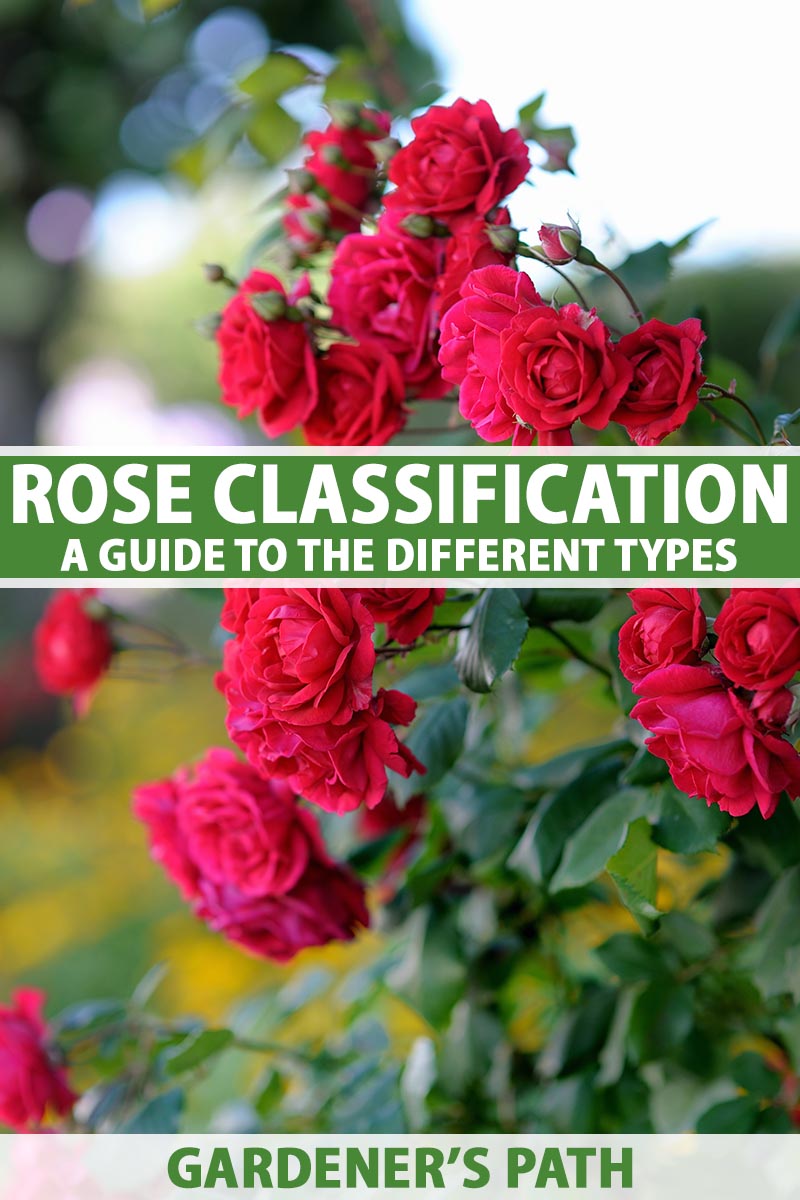
We link to vendors to help you find relevant products. If you buy from one of our links, we may earn a commission.
Even to experts, rose classifications can be a complicated subject.
We’re going to shed some light on the topic. Here’s what you can expect:
What You’ll Learn
How Roses Are Classified
Alright, get your notebooks out, because we’re about to dive into it.
The American Rose Society is the official registrar of new roses for the entire world and is known as the “International Registration Authority for Roses.” They’re the ones who decide how new cultivars are categorized.
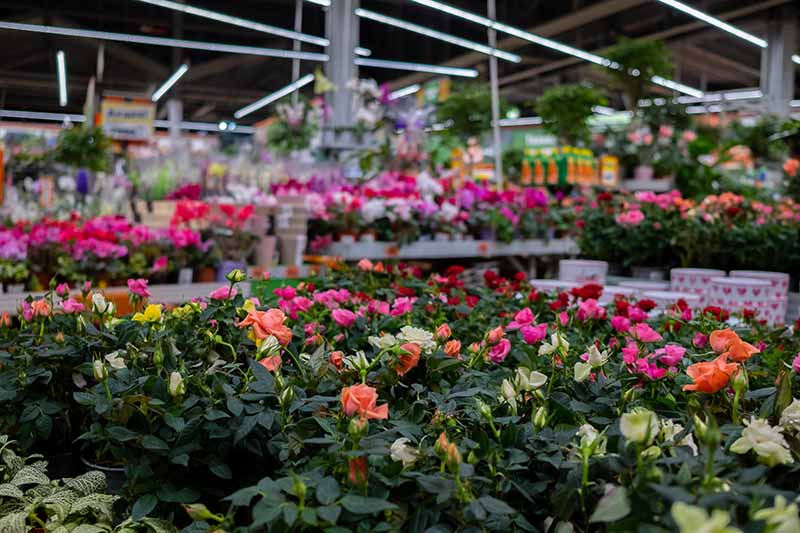
Broadly, there are three major groups: old garden, species, and modern.
According to the American Rose Society, all roses are classified into several additional groupings, as either species (or wild), old garden (or antique), modern, hybrid tea and grandiflora, floribunda and polyantha, miniature (or miniflora), climber, or shrub.
Then there are further sub-classifications, like bourbon, China, damask, hybrid wichurana, ramblers, and large-flowered climbers. We won’t cover all of them here, but we will discuss some of the more popular sub-classifications.
First, let’s talk about old gardens. Alba, (or white roses), Ayrshire, bourbon, boursault, centifolia, China, damask, gallica, moss, noisette, Portland, and tea are all old garden roses. These were all types that existed before 1867, when the first hybrid tea was introduced.
Speaking of, the first hybrid tea was created by French flower breeder Jean-Baptiste Andre Guillot, which he named ‘La France.’
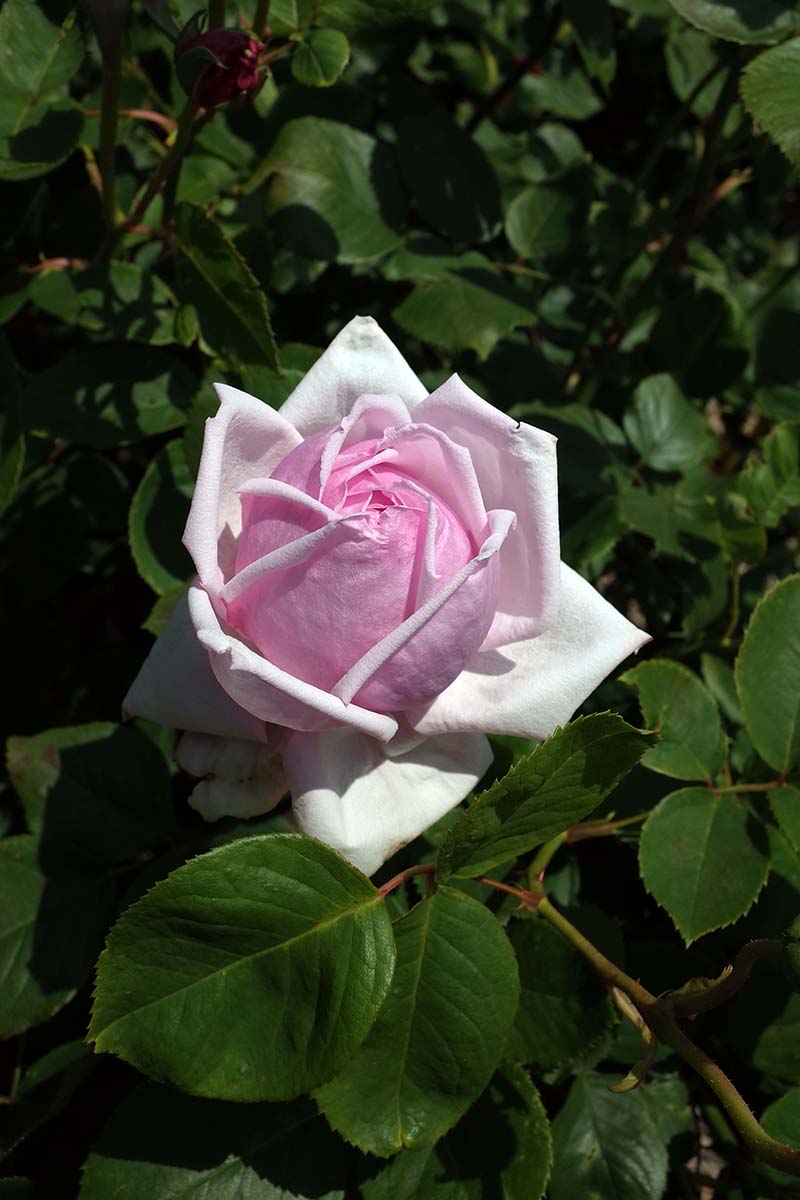
If this isn’t confusing enough for you, there’s more, so stick with me. You can generally group old garden types into two categories.
The first is plants that were bred from the China rose (R. chinensis), which tend to be repeat bloomers.
Then there are those that were bred before R. chinensis was introduced to Europeans in about 1792. These tend to bloom only a single time. Whew!
Moving on, modern types include floribunda, grandiflora, hybrid musk, hybrid rugosa, hybrid tea, hybrid wichurana, miniature, miniflora, polyantha, and shrub roses.
Species, or wild roses, are classified all by themselves.
Now I’ll let you in on a little secret. There really isn’t any technical process for determining whether a rose is classified as a hybrid tea rather than a polyantha, for example.
When a breeder creates a new hybrid, they decide how to classify it when they register it with the American Rose Society.
That means a breeder might decide to classify a hybrid that they bred from a hybrid tea and a polyantha as a polyantha.
They can do this even if the plant appears to have more characteristics of a hybrid tea. But you don’t even have to choose one of the parent plants when you’re classifying a new plant.
Some breeders choose to classify their hybrids as whichever type is most popular at the time to help its chances commercially, or because they aren’t sure exactly what the parentage is.
Others ignore parentage and choose to classify a plant according to its appearance, so it might technically be a grandiflora-tea hybrid, but it looks more like a floribunda, so that’s how it is classified by the breeder.
There is an official classification committee, and they are working on sorting things out so that they are a bit more organized, but for now, this is how things stand.
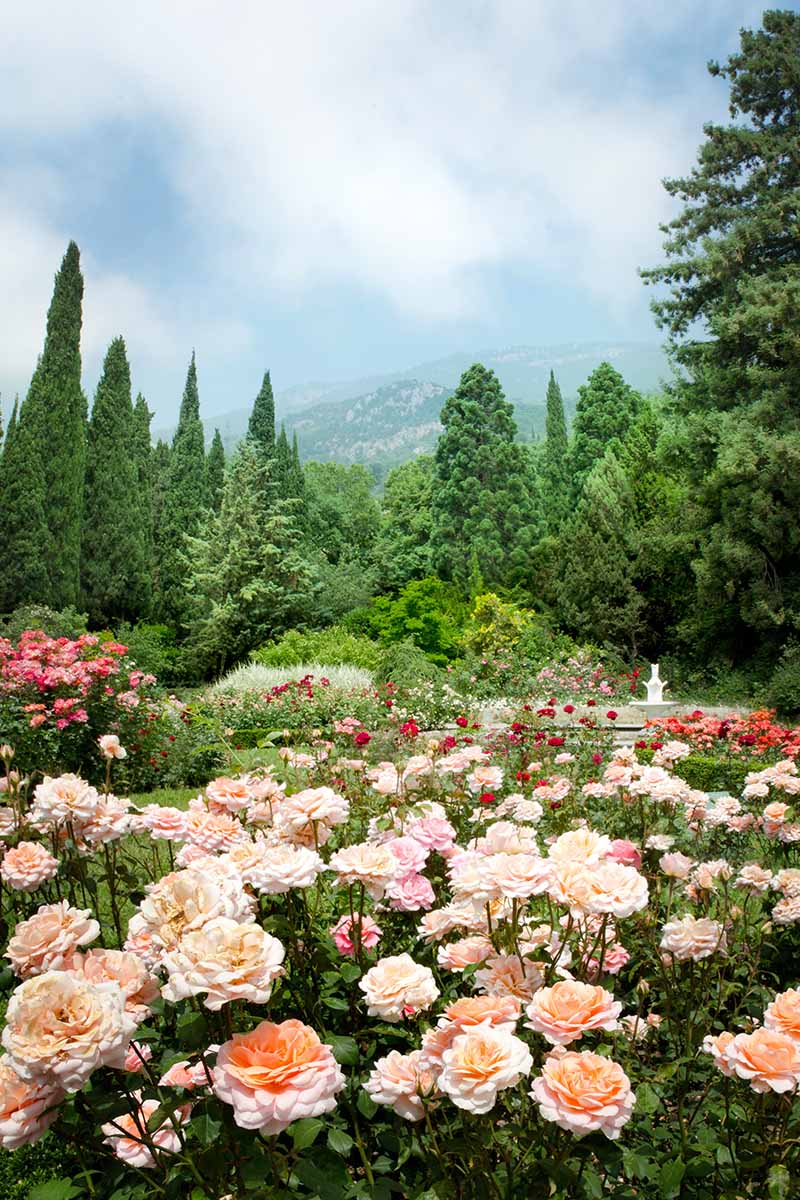
In other words, don’t become too wrapped up in classifications.
While it’s useful to know them because they give you a general idea of how a type will look and behave, the most important thing is to read up on the specific cultivar itself.
You might think you are looking for a floribunda because you want a plant that has abundant blossoms, but you might end up picking a polyantha that is a more abundant bloomer than the typical floribunda.
Or take the ‘Montecito’ cultivar. It’s classified as a shrub, so you might buy it to act as a cute little accent in the garden next to your house. But it grows up to 50 feet tall, so you’d be in for a big surprise if you didn’t read up on its characteristics first!
Below are the different classifications and a few of my favorites from each one.
How did we pick these particular plants?
The recommended cultivars and hybrids in this guide are more disease resistant, require less pruning, are known to be generally healthy and hardy, or aren’t bothered as much by pests as other varieties out there, so it’s easier for the newbie to keep them happy and healthy.
Don’t feel overwhelmed. Keep in mind that the best one for you and your garden is going to be one that was developed to grow in your zone and conditions, and that has the characteristics that you’re looking for.
In addition to reading this guide and our guide to growing roses, if you still have questions or need suggestions, your local extension office is an invaluable resource for figuring out the ideal bloomer for you.
Damask
Damask roses fall under the old garden grouping, and while they are beautiful and all, my goodness do they smell incredible.

Damask is considered the quintessential rose scent in the perfume industry because it is rich, sweet, spicy, and floral.
When you buy a rose-scented candle or perfume, it’s the damask scent the manufacturer is trying to recreate.
Damask is also the type that is most often used to make rose water, powdered roses, and oil.
Watch out, though. They’re also some of the thorniest cultivars out there, so smell but don’t touch! Generally, they grow to about seven feet tall and four feet wide, and most have foliage that is somewhat grayish-green.
‘Botzaris’ has stunning snow white flowers with masses of petals on a compact shrub. It has a particularly pungent damask scent.
‘Madame Hardy’ (also known as ‘Felicite Hardy) lives up to her name. This classic white type can handle some shade and the clusters of blossoms have a delicate lemon scent.
These bloom just one time per season, but they produce a ton of flowers.
Floribunda
Floribundas are in their own classification category and were created by hybridizing tea and polyanthas.
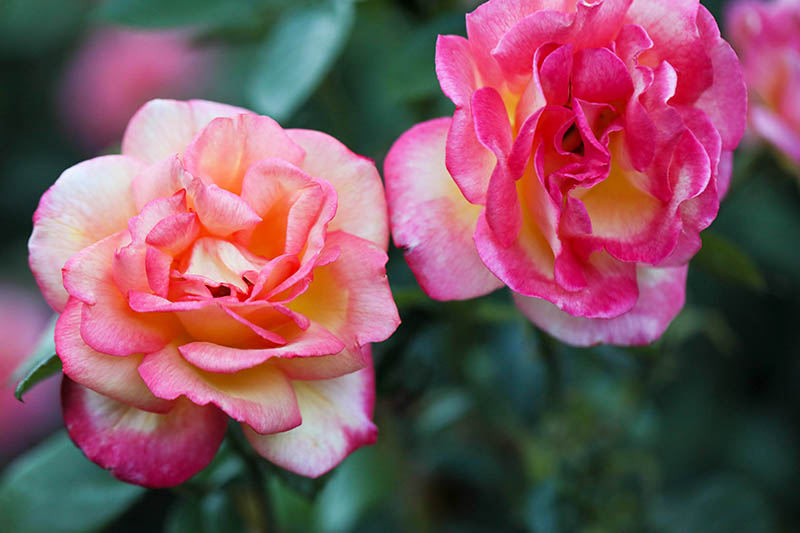
They retain some of polyantha’s hardiness and produce bouquet-like clusters of flowers. The individual blossoms are smaller than those of hybrid teas, but you generally get more of them per plant.
Floribundas tend to do better in cold and wet weather than hybrid teas and bloom continually, rather than in cycles of every six to seven weeks like hybrid teas do.
One of the best cultivars to start with is the climber ‘Cinco de Mayo,’ which you can pick up at Amazon in a gallon-size pot.
This cheerful non-grafted rose has clusters of stunning blossoms, which feature a smoky orangish-red color with hints of lavender and magenta.
The flowers have a mild apple scent. It’s a continual bloomer that is resistant to disease and doesn’t require a ton of pruning.
‘Ebb Tide’ has a shrublike growth habit with double blooms in a stunning dark plum color. It’s a repeat bloomer with an intense clove scent.
Grab one of these moody beauties at Nature Hills Nursery.
‘Mango Veranda’ is a repeat bloomer with double blossoms that is happy to grow without much fuss from you, if you are able to provide the right conditions.
It has mango-scented petals in a lovely shade of salmon blended with copper. And it stays fairly compact, so it’s nice for containers.
Nature Hills Nursery carries ‘Mango Veranda’ plants in #1 or #2 containers.
Grandiflora
Grandifloras are their own classification and were created as a cross between hybrid tea and floribundas.
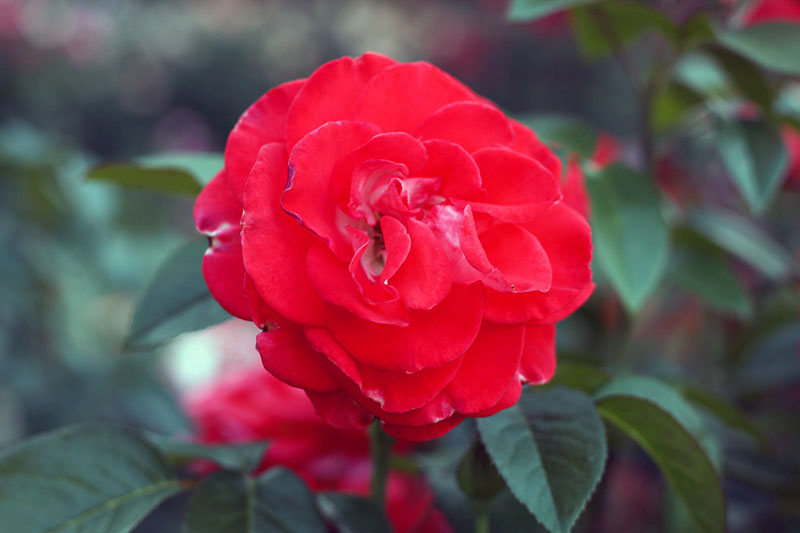
The blossoms are the size of tea roses but they cluster together like those of a floribunda. They tend to grow taller than any other modern type – up to nine feet or more.
The downside is that they lack that strong fragrance of other types.
‘Crazy Love’ is so pest and disease-resistant that you may forget it’s a rose. It has coppery orange double blossoms and an intense floral fragrance.
‘Queen Elizabeth’ produces picture-perfect blooms that deserve a royal crown.
The ruffled, delicate pink blossoms grow in an elegant cupped shape. This was the first grandiflora ever introduced.
The long, straight stems mean they’re perfect for cutting and bringing indoors for use in arrangements.
Home Depot carries this incredibly popular option as a dormant rootstock.
Hybrid Musk
Hybrid musks fall under the modern classification and are highly fragrant and disease resistant. They can handle part shade and die back to the ground each year in colder climates.
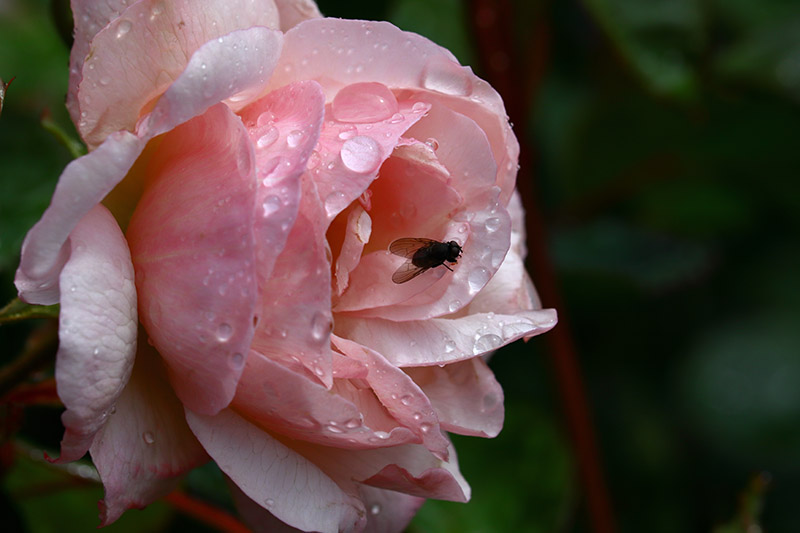
‘Lexy’ has clusters of 70-petal blossoms in delicate pink. It resists pests and disease and blooms continually without deadheading throughout the growing season.
‘Penelope’ is often described as “vigorous” because it grows rapidly, and this variety is hard to kill, even with a little neglect.
It has semi-double blossoms that are a delicate yellow at the base fading to pale pink on the tips. It has a heady, bold fragrance that will knock you off your feet.
Hybrid Tea
Hybrid teas, which have their own classification, and are the most popular type right now because they have picture-perfect blossoms that are large and fragrant.
There is usually one flower per stem, making them ideal for cutting.
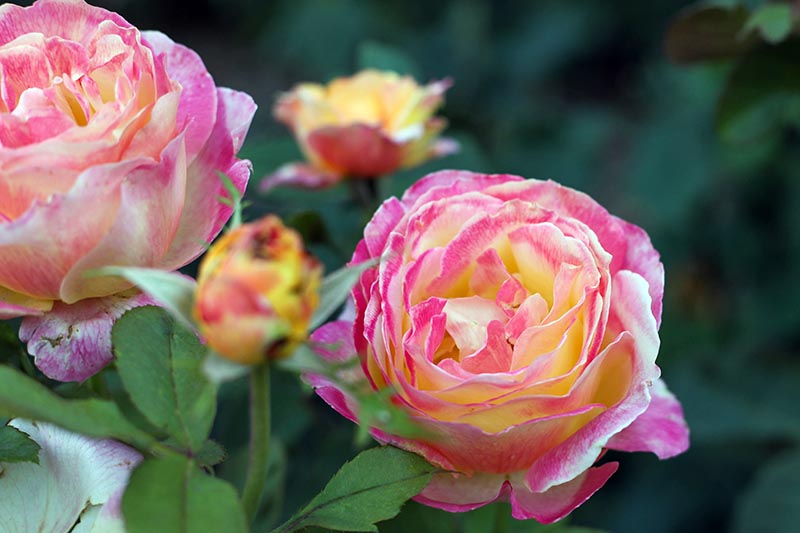
‘Mellow Yellow’ has – you guessed it – yellow double blooms, with a fruity scent to boot.
These are reliable growers and the stems are long and straight, so they’re perfect if you want to cut the flowers for arrangements.
‘Sunny’ Knock Out is a particularly drought and disease tolerant cultivar in the Knock Out® series with gorgeous yellow continual blossoms.
You can find ‘Sunny’ Knock Out plants in #2 and #3 containers available at Nature Hills Nursery.
If you want a flower that will turn the neighbors’ heads (as well as your own), plant ‘Double Delight.’
Inducted into the World Federation of Rose Societies Hall of Fame in 1985, ‘Double Delight’ hits all the right spots.
The scent alone makes it a worthy addition to the garden, with intense notes of spice, and then there are the blossoms.
The soft, massive petals start out buttery yellow in the center and fade to a strawberry red toward the outside of each bloom.
The color holds true even when the sun is doing its best to fade and burn more tender plants.
The stems grow long and straight, so you can bring the long-lasting blossoms indoors for a floral display.
Home Depot carries this beauty in the form of dormant bare roots, in case you’re interested – and why wouldn’t you be?
‘Peace’ is one of those flowers that whispers rather than shouting.
It doesn’t have boldly-colored blossoms, but the delicate blooms feature a creamy yellow center that fades to a delicate blush pink.
This is a popular vigorous grower, and dormant rootstock is available from Home Depot.
Large Flowered Climbers
Originally part of the modern category, large flowered climbers are now categorized on their own as they gain popularity.

Large flowered climbers are characterized by – you got it – really large blossoms and a climbing growth habit… usually.
This category is sort of a catch-all for climbers that don’t fit under any other classification. Some are repeat bloomers, and they are generally hardy in Zones 4 to 9.
But again, be sure to read up on the specific cultivar, because there are some plants in this category that don’t climb much higher than four feet.
Wicuranas are the variety that some people know as ramblers, while gigantea tend to have a cascading growth habit.
‘Altissimo’ is a classic large-flowered variety from this category. It grows about nine feet tall with masses of large, blood-red blossoms. It blooms continually all summer long.
Miniflora
Miniature and miniflora types only grow to be an average of about 18 inches tall and have proportionately small blossoms. You can’t go wrong with any mini cultivar, and they all are perfect for beginners.
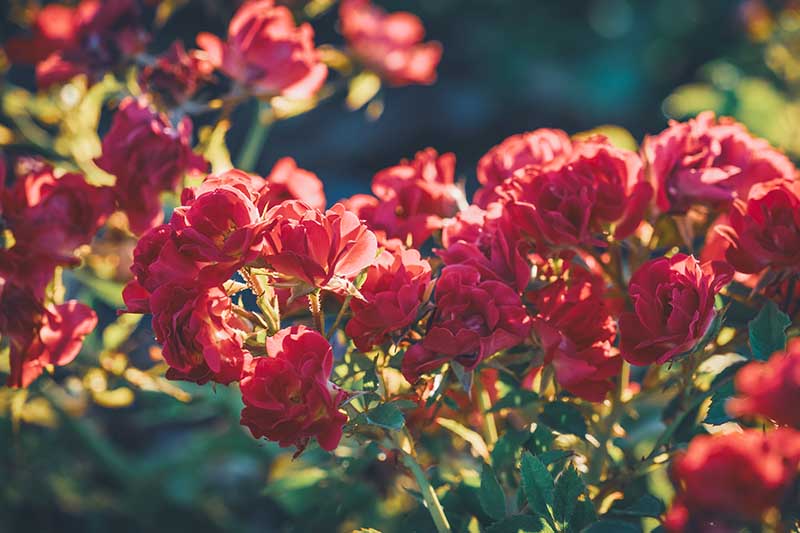
That’s because they don’t require complicated pruning, they resist pests and diseases, and they can handle a variety of soils.
A category in and of itself, you can also find minifloras that are miniaturized hybrid tea types or expressions of other rose forms.
‘Sweet Sunblaze’ has tiny pink double blossoms on an 18-inch plant.
While the flowers are small, you’ll get a ton of them.
If you want one for your container or yard, Nature Hills Nursery has plants available in #2 containers.
Modern
The modern classification is sort of a catch-all for a group of different roses bred after 1867.
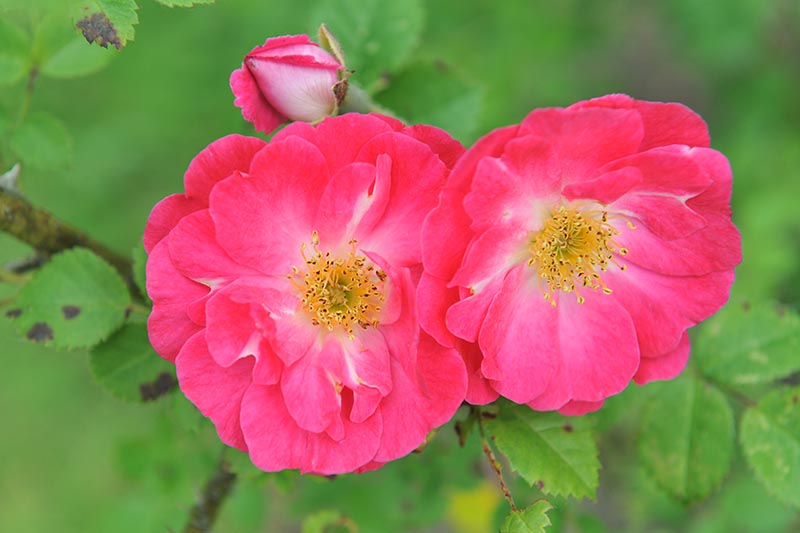
Technically, types like grandiflora and polyantha are modern, but they have their own categories according to the American Rose Society. That’s because they have become quite a distinct class on their own, with unique growth habits.
Modern types that don’t have their own classification include hybrid kordesii, hybrid moyesii, hybrid musk, and hybrid rugosa.
Rugosa roses are a good option for people who live in cold climates or who have struggled with keeping their plants alive.
They’re drought tolerant, disease and pest resistant, and don’t need much maintenance. In fact, they do best when you only fertilize them rarely, if at all.
Parkland is a series of rugosa hybrids bred in Canada, where this type is particularly popular. ‘Morden Sunrise’ features double yellow-orange blossoms with dark green foliage.
All of the plants in this series grow in Zones 2 to 7.
Moss
I want to call out moss and climbing moss roses because I can’t tell you how often they get confused with moss rose (Portulaca grandiflora), which is from the same family as purslane.
Moss roses from the Rosa genus are actually antique roses that stand out because of the hairy, greenish-brown growth that forms on their leaf stalks, calyces, flower stalks, and stems.
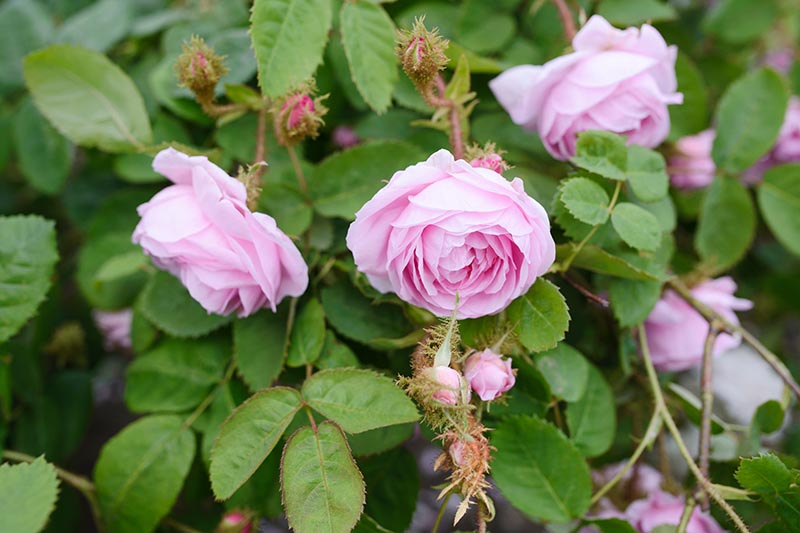
This “hair” is incredibly soft and excretes a sticky substance that has a strong scent that smells like a cross between a damask, a pine tree, and an apple.
This old garden category plant is a centifolia damask hybrid, which accounts for its scent.
Gaining massive popularity in the 1800s before fading out, they grow to about eight feet tall and four feet wide. Sadly, they aren’t widely available these days.
If you find one in your area, I highly recommend giving it a try. Beyond the stunning smell, the frilly blossoms come in deep, vibrant fuchsia, crimson red, pastel pink, and even pink stripes.
Most are one-time bloomers, but you’ll have a ton of blossoms during that period. Some are repeat bloomers, though.
‘Lilac Pink’ is a single bloomer with fragrant, fuchsia double blossoms that grows best in Zones 6 to 10. The blossoms stick around for weeks, but they also make great cut flowers for a floral display.
‘Capitaine John Ingram’ has massive, dark crimson double blooms. It’s another single bloomer and also does best in Zones 6 to 10.
Old Garden
Old garden types, often called old-fashioned, antique, or heritage roses, are heirlooms that existed before the first hybrid teas were bred.
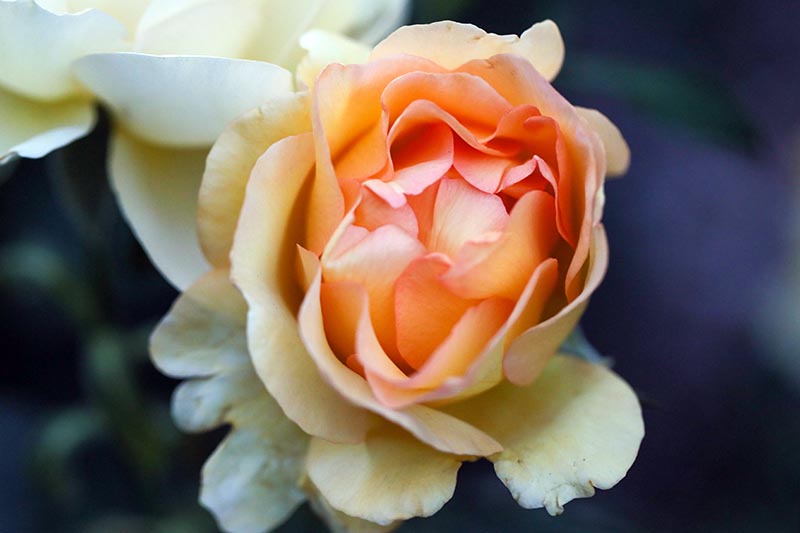
The flowers smell incredible, they have colorful hips that are ideal for use in cooking, and they are resistant to insects and disease.
The downside is that they’re a bit more finicky to grow than some types, and they don’t continue blossoming for as long as other varieties. Some blossom just once and are done. Most are hardy in Zones 4 to 9.
‘Alba Maxima’ is an Alba variety, likely a descendant of the ‘Alba Semi-Plena.’
If you’ve ever heard of the White Rose of York, dating back to the War of the Roses in 15th century England, it was most likely an ‘Alba Semi-Plena’ cultivar that the members of the House of York favored as their symbol.
This lovely double-bloom ivory white flower is incredibly fragrant and hardy. Sometimes called the Jacobite rose or ‘Great Double White,’ it also has large, tasty hips that make a beautiful display on the plant in the fall.
‘Cardinal de Richelieu’ is a hybrid gallica with burgundy blossoms that flower continually from spring through midsummer.
It’s a vigorous grower that is tolerant of neglect and of colder climates all the way down to Zone 3. The hips are particularly large.

‘Marie Pavie’ has semi-double flowers in a delicate light pink color. They are intensely fragrant, and grow on thornless stems. This repeat bloomer lends itself well to containers or hedges.
This is one of the hardier antique types. It can withstand cold weather down to Zone 3, wet weather, and diseases better than some others.
‘Sydonie’ (or ‘Sidonie’) is one of my all-time favorites, not just in the antique category, but of any classification.
It’s a Portland rose with perpetual double blossoms that have over fifty petals in a medium pink color that is darker towards the center, and fades to a lighter color at the edges.
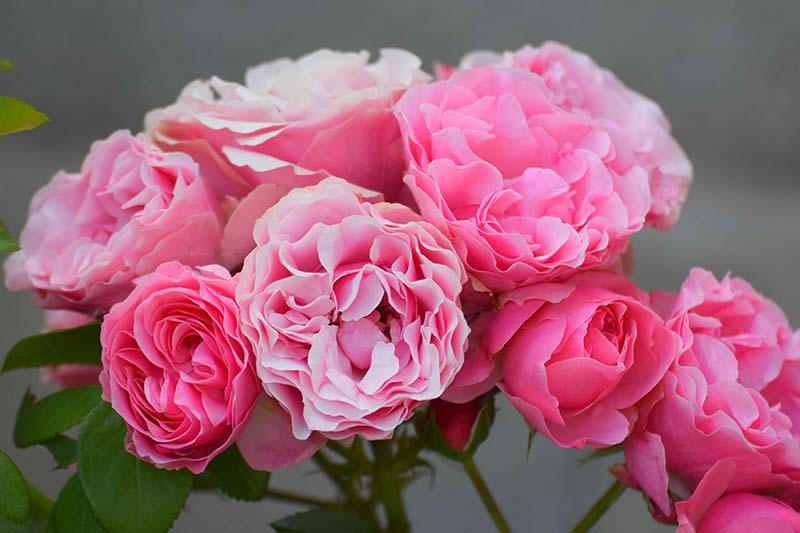
The large blossoms also have an intense damask-like fragrance and the stems aren’t extremely thorny. Honestly, people often mistake it for a peony in my garden, so if you love the look of a peony but want the characteristics of a rose, pick this one.
Unlike many Portland roses, it’s disease resistant. It doesn’t do as well in the cold, however, and is only hardy down to Zone 5.
Polyantha
Polyantha plants are compact and feature cupped blossoms that bloom all summer long. They’re known for being tough and disease resistant without needing a ton of pruning.
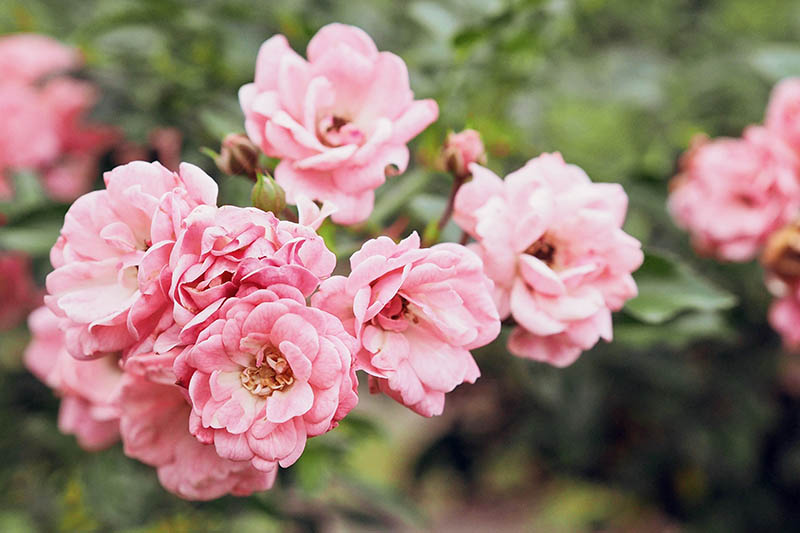
Some of them are climbers, others are compact enough for growing in containers, and many of them are great as hedges.
‘Cecile Brunner’ looks like a delicate tea rose, but don’t let it fool you. This pretty pink specimen is a sturdy plant, known for its pest and disease resistance, and with more tiny blossoms than you’ll know what to do with.
You can enjoy a whiff of the intensely sweet fragrance whenever you walk within 10 feet of it, and this type is perfect for climbing all over a large arbor.
Species or Wild
Wild roses, also known as species types, are those that grow in nature – or are at least more closely related to the wild plant that started it all.
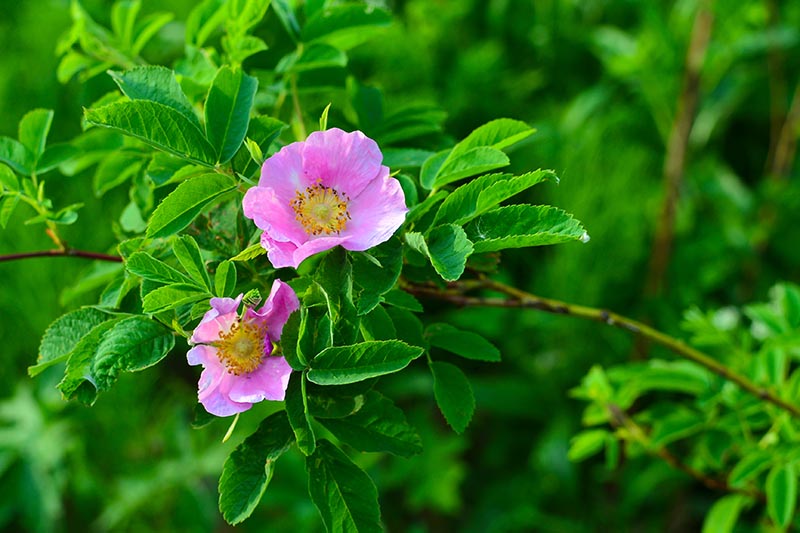
Technically, many so-called wild varieties that you can purchase have been bred over the years to create larger blossoms and more colors than nature provides.
Then there are the true wildflowers that you can find growing across North America, Europe, and Asia. These come in fewer colors, with pink being the most common. You’ll also see a few red, yellow, white, and purple options.
The simple flowers only have five petals. And they’re all vigorous and resistant to diseases.
While they aren’t as highly prized for their blossoms, which tend to be a bit less showy and full than the modern cultivated types, their hips are perfect for making jam.
The plants spread readily through seedlings or suckers, and they can take over an empty corner of the garden.
If you are really scared to get going with these flowers, pick a wild variety. These need hardly any attention, can thrive in just about any type of soil, and aren’t too fussy about sun exposure.
You don’t need to deadhead or prune them to keep them blooming and healthy. The only pruning you will need to do is to limit their spread. In fact, your biggest challenge may be keeping the plants in check.
When I was a kid, my teacher sent me home with a potted wild rose as a reward for good grades. After a few years, my mom wanted to get rid of it to establish a raised bed garden.
I stubbornly dug it up myself, getting maybe six inches of the roots, and planted it in a part of the garden that I selected because I didn’t think my mom would notice, since nothing else was growing there.
It was a partially shady spot and with absolutely no soil prep, I plopped my trophy in the ground. Can you believe it not only survived, but took off and filled in the entire area without any help from me? That’s how hardy wild types can be.
‘Lady Banks’ has sunny yellow flowers with frilly miniature petals.
It has a climbing, vining habit, so it’s ideal if you want something to decorate an arbor or to display as a low-growing accent.
As an added bonus, it’s thornless, so if you do decide to prune, you won’t be nursing bloody fingers.
Home Depot has live plants available in 9.25-inch pots if you want to make this one a part of your garden.
‘Marbled Pink’ has semi-double blossoms that fade from the white center to a pale pink on the tips of the petals. The blossoms are about a half inch wide.
‘Hemisphaerica’ has one-inch, vibrant yellow double blossoms. They almost appear to be like old types because they’re so frilly and full, but these are wild ones.
Dog roses are classic climbers with five-petaled pink blossoms that have milky white centers. The hips are hard to beat.
They are plump, juicy red treasures that can be used to make an intensely flavorful syrup. And they’re also a good option if you’re hoping to use the hips medicinally or in tea.
Shrub
While the term “shrub” may refer to a growth pattern, it’s also often used as a designation for a shrub-like type that is hardy and doesn’t fit into another of the categories described above.
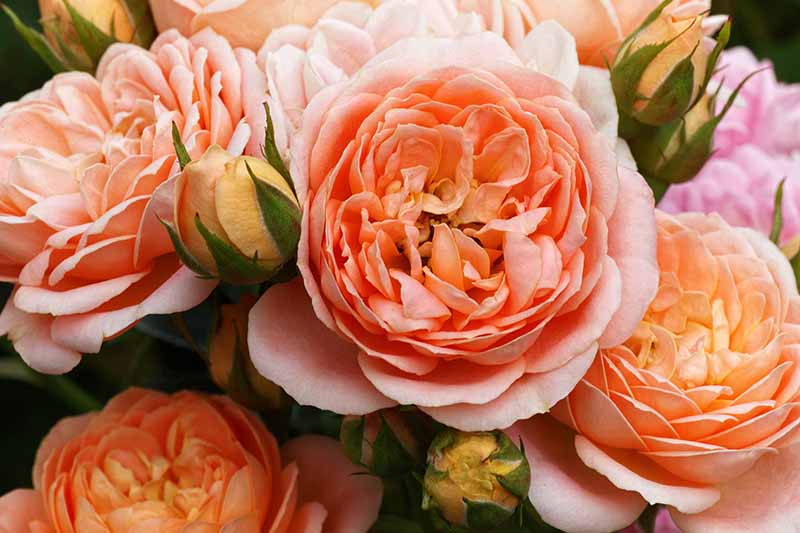
If you’ve ever heard of “English roses,” created by the breeder David Austin, these fall into the shrub classification.
You really could put the Knock Out® series in a classification of its own since it has become incredibly popular and varied.
But it’s considered a shrub, though climbers and miniature sizes are available as well.
Knock Outs are an excellent option for beginning growers because they are disease-resistant, maintain a compact growth habit without intense pruning, are drought-tolerant, and don’t require deadheading.
The Knock Out® series was first developed in 2000 and quickly became the best-selling rose in the US!
The breeder wanted it to be the ultimate “low maintenance” grower. These come in a variety of colors and sizes, including bright red, peach, yellow, white, and pink.
You can find Knock Out® just about anywhere that sells these beautiful plants.
Home Depot has many different colors available.
Knock Out® Petite (aka ‘Meibenbino’) is a smaller version of the popular Knock Out® hybrid. It’s low maintenance and produces lots of blossoms on a compact plant.
They come in bright, fire-engine red.
You can find plants at Nature Hills Nursery in quart-size or #2 containers.
Read our full guide on growing and caring for shrub roses here.
Color Classes
Not another class! Don’t worry, this classification system is much easier. All new hybrids are assigned a color class when they are registered. There are eighteen colors:
- White (or white blend)
- Light yellow
- Medium yellow
- Deep yellow
- Yellow blends
- Apricot (and apricot blends)
- Orange (and orange blends)
- Orange-pink (and blends)
- Orange-red (and blends)
- Light pink
- Medium pink
- Deep pink
- Pink blend
- Medium red
- Dark red
- Red blend
- Mauve (and mauve blends)
- Russet
You’re probably asking yourself, “Where’s the purple!?”
There are absolutely purple ones out there, like the stunning ‘Ebb Tide’ floribunda, but there isn’t an official purple category.
Purple roses are usually classified as mauves, but they’ll also sometimes fall under the red or pink categories.
Now You Know Your Roses!
You did it! You made it through your master class on classifications. Now, when you hear people talking about these plants, you’ll know what the heck it means when someone references a damask or species.
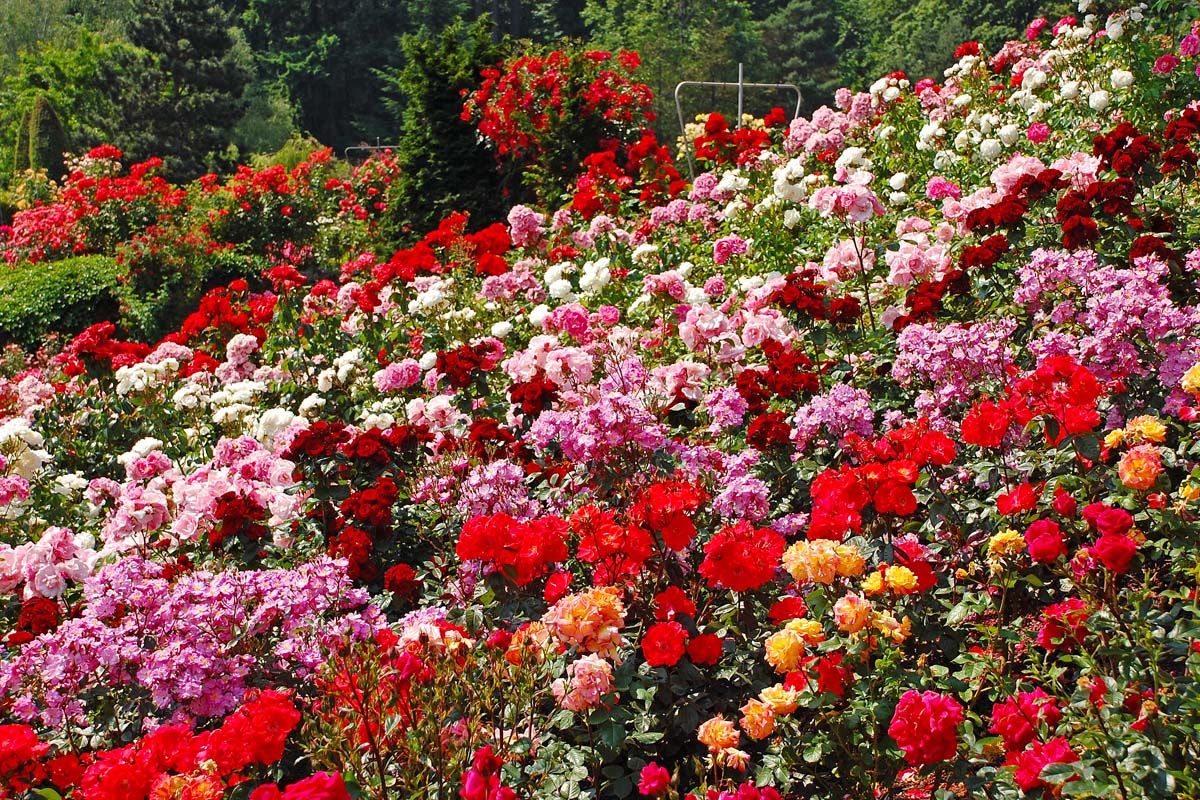
You can also head to the nursery and confidently tell them you’re looking for a russet floribunda and know exactly what you’ll get (and I’ll bet, in that case, they come back with the stunner ‘Hot Cocoa’).
Hopefully you enjoyed getting into the weeds, erm, roses as much as I did writing about them.
If you end up picking up one for your garden, come back and let us know in the comments section blow which classification you decided on – and feel free to share a picture!
And to learn more about growing roses in your garden, check out these guides next:
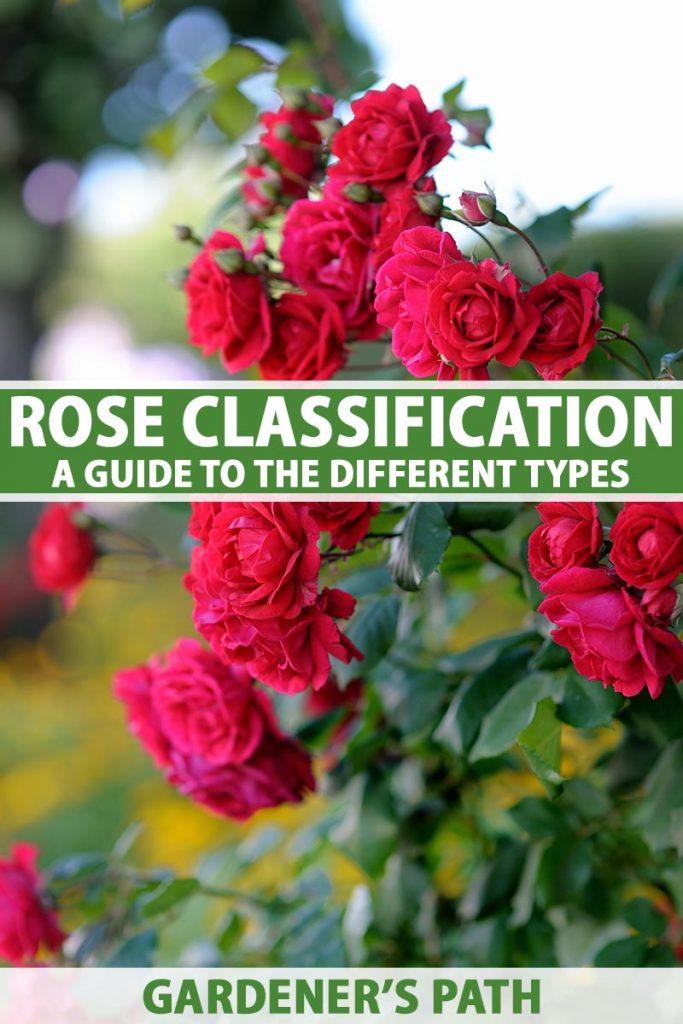
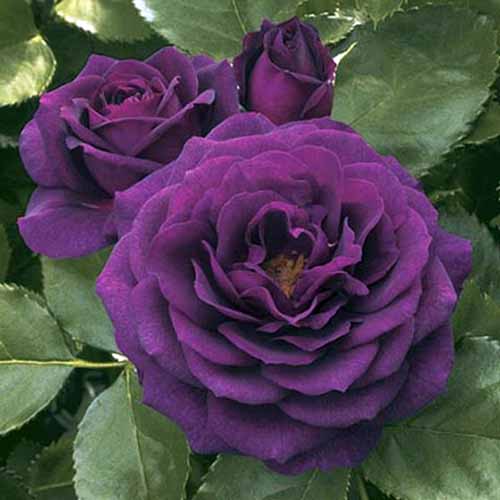
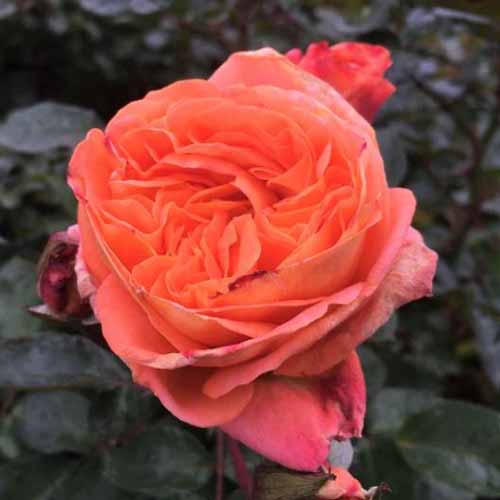




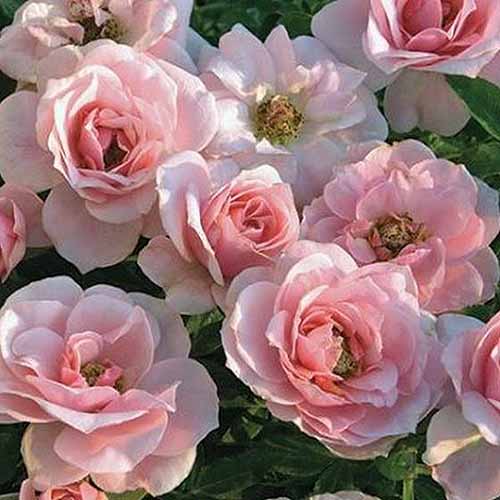
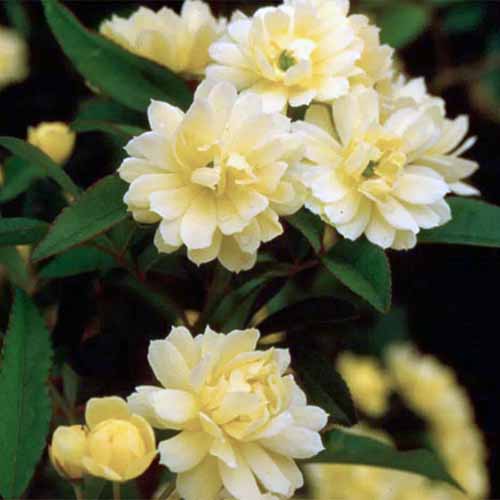
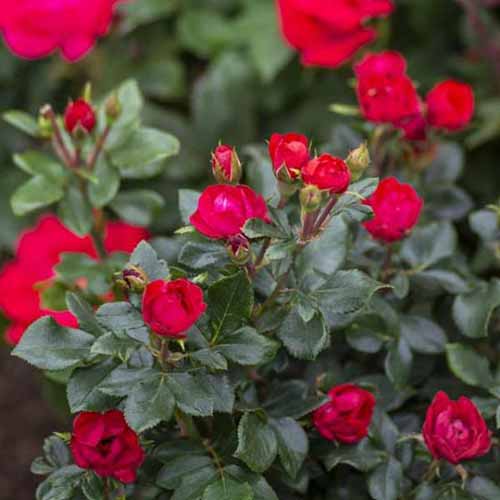

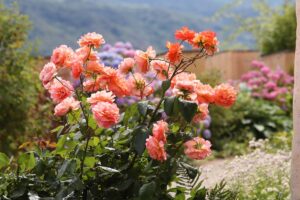

terrific help
I have been growing roses for years (learnt from My mother who definitely had green fingers) but always get confused with the category.
So I Usually go for pinks, whites and the occasional red
but mostly for fragrance.
Love to smell roses as I walk round the garden or sit outside to read or entertain.
Thanks for the lesson.
So glad this guide helped! I’ve been known to pick a rose solely on its scent, so I understand completely.
What are black and blue roses classified as?
Hi Frances, thanks for the question. Just a bit of clarification: there aren’t any truly black or blue roses. There are white roses that are dyed blue or black and there are a few roses that are deep red or purple. Some almost look black.
Most of these deep red roses are hybrid teas, floribundas, or shrubs, but they can fit into any category. If you have any specific roses that you’d like me to help identify, I’d be happy to do so!
Hi! I love roses!!! Love to look/ smell/ feel and read about them. My husband grows them. Thank u for this article… so informative.
I share your passion! Happy our article was useful!
Great article.
I need help or a reference to learn about the shapes or forms of tree roses.
Some say perfectly round like a Julia child.
Is there a way to know what shape a floribunda will be?
Thank you
Hi Steve! We actually have a guide to tree roses that you might find useful. The shape of your tree rose is totally dependent on what you give it and there’s no set requirement. In general, the main goal is that it be symmetrical, but that’s not a requirement. If you like a perfectly round shape, go for it. Some people go for a more weeping form, others go for multiple balls rather than just one standard head. Hopefully, our guide can shed more light on the subject for you.